|
|
|
Sort Order |
|
|
|
Items / Page
|
|
|
|
|
|
|
| Srl | Item |
| 1 |
ID:
096269
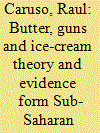

|
|
|
|
|
| Publication |
2010.
|
| Summary/Abstract |
This paper is intended to complement the existing literature on civil wars. First, it presents a simple theoretical model of conflict that defines a two-sector economy. In a contested sector, two agents struggle to appropriate the maximum possible fraction of a contestable output. In an uncontested sector, they hold secure property rights over the production of some goods. Agents split their resource endowment between 'butter', 'guns' and 'ice-cream'. Following the theoretical insights the empirical analysis focuses on the relationship between civil wars and different sectors of the economy. In particular, a panel probit specification shows that the incidence of a civil war decreases in the size of manufacturing sector.
|
|
|
|
|
|
|
|
|
|
|
|
|
|
|
|
| 2 |
ID:
143324
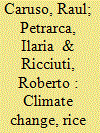

|
|
|
|
|
| Summary/Abstract |
This article contributes to the literature on the nexus between climate change and violence by focusing on Indonesia over the period 1993–2003. Rice is the staple food in Indonesia and we investigate whether its scarcity can be blamed for fueling violence. Following insights from the natural science literature, which claims that increases in minimum temperature reduce rice yields, we maintain that increases in minimum temperature reduce food availability in many provinces, which in turn raises the emergence of actual violence. We adopt an instrumental variable approach and select the instruments taking into account the rice growing calendar. Results show that an increase of the minimum temperature during the core month of the rice growing season, that is, December, determines an increase in violence stimulated by the reduction in future rice production per capita. Results are robust across a number of different functional specifications and estimation methods. From a methodological point of view, we claim that the inconclusive results obtained in this literature may be caused by an overlook of the correct bundle crop/temperature. Studies concentrating on several countries with different crops and using variations of average temperature as a measure of climate change missed the biological mechanism behind the relationship between climate change and violence.
|
|
|
|
|
|
|
|
|
|
|
|
|
|
|
|
| 3 |
ID:
117692
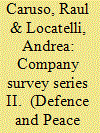

|
|
|
|
|
| Publication |
2013.
|
| Summary/Abstract |
Finmeccanica is the eighth largest arms manufacturer on a world scale. The article explains and discusses its recent evolution. In particular, we discuss the broader privatisation programme implemented by the government as a response to the 1992 financial crisis. Finally, we will present our conclusions on how the interplay of domestic factors and external pressures accounts for Finmeccanica's peculiar trends. This result, especially Finmeccanica's performance, is the consequence of a deep transformation occurred in the past 10-15?years in both the industrial base and national defence policy. The two processes appear to be somehow interrelated.
|
|
|
|
|
|
|
|
|
|
|
|
|
|
|
|
| 4 |
ID:
116233
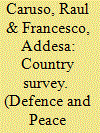

|
|
|
|
|
| Publication |
2012.
|
| Summary/Abstract |
This paper analyses the military expenditures in Italy over the period 1988-2008. The estimation of a conventional model of military expenditure shows that the choices of military expenditure by Italian governments are influenced by US and, to a lesser extent, the other NATO countries' defence spending. In particular, the negative association between the US and NATO average military expenditure on the Italian one suggests a free-rider behaviour of Italy. Eventually, we focus on the relationship between productivity and military expenditure. The results suggest that there is a negative association between productivity and military expenditures in the long run. Namely, if military expenditures were substituted by civilian expenditures, the Italian overall productivity would be expected to improve.
|
|
|
|
|
|
|
|
|
|
|
|
|
|
|
|
| 5 |
ID:
151712
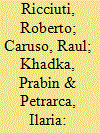

|
|
|
|
|
| Summary/Abstract |
This paper investigates the effect of the deployment of United Nations Blue Helmets on economic activity in South Sudan with a special focus on agricultural production. Since UN troops are predicted to improve security, in particular, we expect a positive relationship between deployment of UN blue Helmets and cereal production. We test our hypothesis using an original data-set including all the 78 South Sudanese counties over the period 2009–2011. We control for the non-random assignment of UN troops through an Instrumental Variables approach. Our empirical results show that a 10% increase in the size of the troop allows the production of additional 600 tonnes.
|
|
|
|
|
|
|
|
|
|
|
|
|
|
|
|
| 6 |
ID:
177826
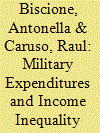

|
|
|
|
|
| Summary/Abstract |
This paper contributes to the literature on military spending by analyzing the relationship between military spending and income inequality in a panel of transition economies over the period 1990–2015. In particular, we exploit three different measures of military expenditures: (i) military spending in absolute terms; (ii) military expenditures per capita; (iii) military burden, namely the ratio between military expenditure and GDP. Findings highlight a positive relationship between military expenditures and income inequality captured by means of three different measures of inequality. Results are also confirmed after we performed a variety of robustness tests. Other results are worth noting and somehow puzzling. For example, military conscription appears to have a redistributional effect and when considering a non-linearity the results show that there could be a concave relationship between military spending and income inequality. In addition, when testing for the ‘crowding-out argument’ results show that expenditures for subsidies are negatively influenced by military spending so confirming the crowding-out argument but there is no significant evidence when considering education and health expenditures.
|
|
|
|
|
|
|
|
|
|
|
|
|
|
|
|
| 7 |
ID:
155298
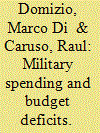

|
|
|
|
|
| Summary/Abstract |
The aim of this paper is to study the relationship between military spending and sovereign debt in a panel of 13 European countries. In particular, under the assumption of the interdependence of military spending between US and European countries, we analyse whether US military spending affected European sovereign debt in the period 1988–2013. The empirical estimation is based on different steps: (i) a unit root test; (ii) an Arellano–Bond panel estimation and a linear fixed effect model; and (iii) a FMOLS estimation to highlight the long run relationship between debt and relevant variables. General results highlight that debt burden of European countries is: (1) positively associated with US military burden and (2) negatively associated with average military burden of other European countries.
|
|
|
|
|
|
|
|
|
|
|
|
|
|
|
|
|
|
|
|
|